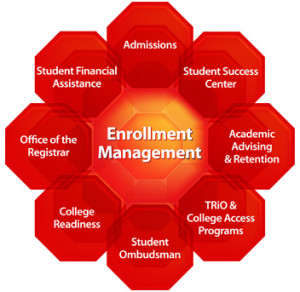In a recent conversation with a few of the senior members of the enrollment management staff for Arizona State University, a colleague said to me, “the odd thing about all of the materials out there about enrollment management is the titles that sound like ‘enrollment management revolution’ or ‘paradigm shifts through enrollment management’; if someone thinks the concepts of enrollment management are new or represent a paradigm shift, they’re already 20 years behind most of the industry.” It set me on an interesting path of reviewing the literature published on enrollment management and, really, something of a historiographical analysis of the field.
My colleague was correct when he said that there wasn’t much new about the idea of enrollment management as a field. Using Google’s NGram tool, which charts the frequency of the appearance of words in literature across time, the phrase ‘enrollment management’ begins to appear in approximately 1975, yielding almost 40 years of material. Interestingly, the frequency trends dramatically upward around the year 1999, begging the question of what drivers might be attendant in that increase.
I was reminded of a frequent frustration I’ve had in reviewing the enrollment management literature, as my reading has not yielded much material on the impact of enrollment management strategy on graduate education. When I came across an article in College & University magazine on the role of Graduate Enrollment Management, I was delighted to see how the work is situated in the field.
In the article, Crossing the GEM Frontier: Graduate Admissions Professionals’ Participation in Enrollment Management, authors Dean Campbell and Jahmaine Smith take on a very interesting topic: the development of professional identity in the field of Graduate Enrollment Management. The article begins with a brief “state of the field” section, wherein the authors describe the blurred line between enrollment management as a set of practices and as a philosophy or a mindset. They also describe enrollment management in a traditional sense as a set of practices that ties together student recruitment, admission, retention, career, and alumni functional groups. The central point of research inquiry questions the process of individual identity development as it relates to the integration of general tasks and responsibilities of the admissions function with the general processes of identity development.
The concept that had the greatest impact for me was the one around professional socialization. This is the idea that supports the general ‘community of practice’ idea that there are internally reinforcing processes that inform identity. There are many components of professional identity: institution, background, communities, professional associations, individual departments, inter-office collaboration, all in addition to the thoughts, beliefs, emotions, culture, and more traditional drivers associated with identity development. But the notion of professional socialization, that knowledge, beliefs, skills, and behaviors are specifically socialized by the different professional communities affiliated with the admissions professional.
The authors detail three components of identity in enrollment management (anticipatory, meaning development, and personal), discuss the details around the role of socializing of structural forces (i.e. institutions, departments, associations), and then the very role of having a field called enrollment management.
There’s some interesting descriptive work in their ‘Methods’ section, focusing on the way they attempted to ensure validity in the qualitative information solicited, the themes identified, and then the development of findings. Interestingly, there’s a great revelation around the source of the labor force in enrollment management being individuals who have worked in some way in the admissions field.
Additionally, there are some interesting discussions of the roles of traditional identity types in enrollment management, how they both reinforce and produce cultural norms and socializing forces. And the conclusion is really around how professional socialization can be used as an effective analytical lens for figuring out how the field works.
Overall, it’s a great article that I think I’ll be able to use in my work. Here are the big takeaways:
- There’s a fantastic bibliography, that indicates the article is well-situated in the literature
- The concept of identity and profession being a framework for analyzing a field, is extremely effective, or at least interesting, when I think about the normative role of executive leadership at the college and university level in higher education administration
- There’s an additional reinforcement to the field with the notion of enrollment management as a set of standard practices, as a set of general styles, and as a philosophy or approach to working.
- The role of the individual in development of strategy and operational design as professionally socially contingent – excellent!
- The role of key socializing factors in defining the ability to be successful as an individual (and by extension as a department and as a unit/school)
REFERENCES
Campbell, C. Dean & Smith, Jahmaine (2014). Crossing the GEM Frontier: Graduate Admissions Professionals’ Participation in Enrollment Management. College and University, Volume 89 (Issue 3), 3-11. http://bit.ly/1oqLmhM
